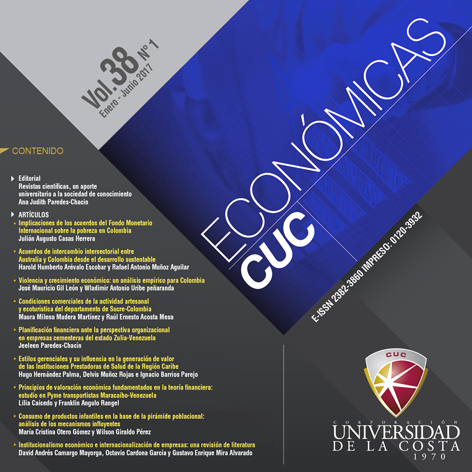Implications of International Monetary Fund agreements on poverty in Colombia
DOI:
https://doi.org/10.17981/econcuc.38.1.01Keywords:
international agreements, poverty, International Monetary Fund.Abstract
This paper analyzes the implications of International Monetary Fund (IMF) agreements on poverty in Colombia. It is shown that during the interventions the fund associated poverty only, with insufficient income, hence their interventions did not reduce the uncertainty of the poor; And although the poverty indicators improved, it is argued that the real possibilities and capacities of the poor did not improve. In order to demonstrate this, it is based on a definition of poverty and the principles underlying the raison d’être of the international organization under study, as well as the aspects that involve uncertainty, as an edge that clarifies that the interventions of the institution increased poverty to Guarantee the profitability of capital.Downloads
References
Acuerdo (1999). Ministerio de Hacienda. Acuerdo extendido de Colombia con el Fondo Monetario Internacional. Santafé de Bogotá D. C., Colombia.
Acuerdo (2002). Ministerio de Hacienda. Acuerdo extendido de Colombia con el Fondo Monetario Internacional. Santafé de Bogotá D. C., Colombia.
Acuerdo (2005). Ministerio de Hacienda. Acuerdo extendido de Colombia con el Fondo Monetario Internacional. Santafé de Bogotá D. C., Colombia.
Beluche, O. (1997). Pobreza y neoliberalismo en Panamá, Recuperado de: http://bdigital.binal.ac.pa/bdp/pobrezayneoliberalismo.pdf.
Brau, E. (2001). Organización y operaciones financieras del FMI, Recuperado de: http://www.elibrary.imf.org/view/IMF054/02390-9781589061149/02390-9781589061149/front.xml?redirect=true
Carrasquilla, A. (2009, 28, Junio). Una fábula y seis moralejas. El Espectador. Recuperado de: http://www.elespectador.com/opinion/una-fabula-y-seis-moralejas-columna-147881.
Casas, J. (2009). El concepto de pobreza y sus implicaciones en Colombia. Revista Apuntes del CENES, 28(47).
Casas, J. (2015). Metodologías de estimación de la línea de pobreza absoluta en Colombia: Una reflexión. Económicas CUC, 36(1), 217-244.
doi: http://dx.doi.org/10.17981/econcuc.36.1.2015.28
Clift, J. (2004). ¿Qué es el Fondo Monetario Internacional?, Recuperado de: https://www.imf.org/external/pubs/ft/exrp/what/spa/whats.pdf.
Coudouel, A., Hentschel, J., & Wodon, Q. (2002). Capítulo 1: Medición y análisis de la pobreza. Banco Mundial, 1.
Elster, J. (1991). Juicios Salomónicos: Las limitaciones de la racionalidad como principio de decisión. Primera edición en español. Editorial Gedisa, Barcelona.
FMI, (2011). Colombia: arrangement under the flexible credit line and cancellation of the current arrangement—staff report; staff supplement; press release on the executive board discussion; and statement by the alternate executive director for Colombia, Recuperado de: http://www.imf.org/external/pubs/ft/scr/2011/cr11162.pdf.
FMI, (2013). Datos básicos, Recuperado de: http://www.imf.org/external/np/exr/facts/spa/glances.htm.
Gamarra, A. (2003). Evaluación de los acuerdos Colombia FMI 1999-2003. Informe sectorial y de políticas públicas. Informe 4.
Garay, L. J. (1998). Colombia: estructura industrial e internacionalización 1967-1996. Biblioteca virtual del Banco de la República, 563-614.
Giraldo, C. (2000). El acuerdo con el Fondo Monetario Internacional: un ajuste que llevará la economía al colapso, Recuperado de: http://cedetrabajo.org/wp-content/uploads/2012/08/27-10.pdf.
Giraldo, C. (2001). Acuerdo de Colombia con el Fondo Monetario Internacional, Recuperado de: https://www.gestiopolis.com/acuerdo-colombia-fondo-monetario-internacional-1999/.
Keynes, J. M. (2014). Teoría general de la ocupación, el interés y el dinero. Fondo de cultura económica.
Kolko, G. (1999). Ravaging the poor: the International Monetary Fund indicted by its own data. International Journal of Health Services, 29(1), 51-57.
Marx, K. (1975). El capital: crítica de la economía política: libro primero. Siglo Veintiuno.
Misas, G. (2002). La ruptura de los 90 del gradualismo al colapso. Univ. Nacional de Colombia.
Moncayo, V. M., & Rojas, F. (1978). Luchas obreras y política laboral en Colombia. La carreta.
Ocampo, J. A., Bajraj, R., & Martin, J. (2001). Una década de luces y sombras: América Latina y el Caribe en los años noventa. Alfaomega.
Pindyck, R. & Rubinfeld, D. (2009). Microeconomía. Séptima Edición. Editorial: Prentice-Hall.
Robledo, J. (2007). Un Balance Desastroso, Recuperado de: http://www.neoliberalismo.com.co.
Sachs, J. (2013). El fin de la pobreza: cómo conseguirlo en nuestro tiempo. Debate.
Sarmiento, E. (2005). Políticas estructurales contra la pobreza, Recuperado de: http://www.contraloriagen.gov.co/html/RevistaEC/pdfs/310_3_5_Politicas_estructurales_contra_la_pobreza.pdf.
Stiglitz, J. (2009, 13, Junio). Socialismo para los ricos. El Espectador. Recuperado de: http://www.elespectador.com/opinion/columnistasdelimpreso/joseph-e-stiglitz/columna145697-socialismo-los-ricos.
Vargas, M. (2004). Pobreza, mercado y ciudadanía. Revista Iztapalapa, 57, 169-188.
Published
How to Cite
Issue
Section
License
You are free to:
- Share — copy and redistribute the material in any medium or format
- The licensor cannot revoke these freedoms as long as you follow the license terms.
Under the following terms:
- Attribution — You must give appropriate credit , provide a link to the license, and indicate if changes were made . You may do so in any reasonable manner, but not in any way that suggests the licensor endorses you or your use.
- NonCommercial — You may not use the material for commercial purposes .
- NoDerivatives — If you remix, transform, or build upon the material, you may not distribute the modified material.
- No additional restrictions — You may not apply legal terms or technological measures that legally restrict others from doing anything the license permits.


 English
English
 Español (España)
Español (España)














